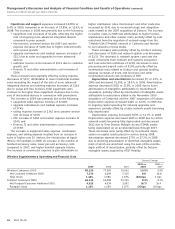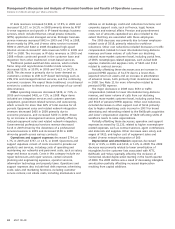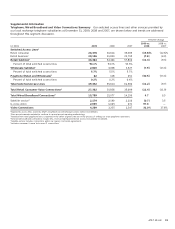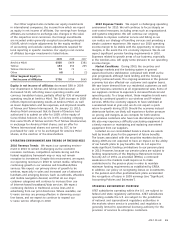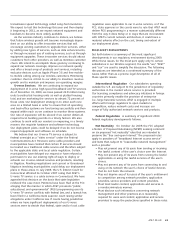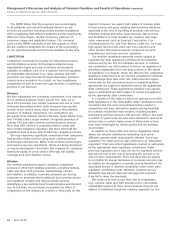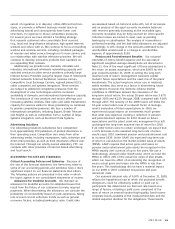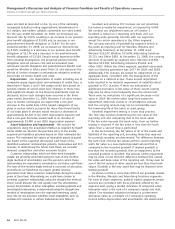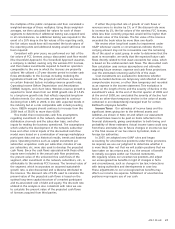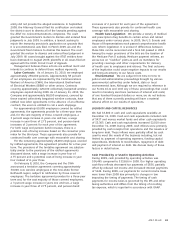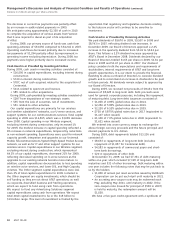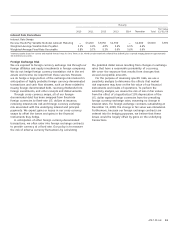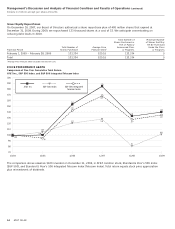AT&T Wireless 2009 Annual Report Download - page 46
Download and view the complete annual report
Please find page 46 of the 2009 AT&T Wireless annual report below. You can navigate through the pages in the report by either clicking on the pages listed below, or by using the keyword search tool below to find specific information within the annual report.
Management’s Discussion and Analysis of Financial Condition and Results of Operations (continued)
Dollars in millions except per share amounts
44 AT&T 09 AR
segment. However, we expect both losses of revenue share
in local service and gains resulting from business initiatives,
especially in the area of bundling of products and services,
including wireless and video, large-business data services
and broadband. In most markets, we compete with large
cable companies, such as Comcast Corporation, Cox
Communications, Inc. and Time Warner Cable Inc., for local,
high-speed Internet and video services customers and
other smaller telecommunications companies for both
long-distance and local services customers.
Our wireline subsidiaries generally remain subject to
regulation by state regulatory commissions for intrastate
services and by the FCC for interstate services. In contrast,
our competitors are often subject to less or no regulation in
providing comparable voice and data services or the extent
of regulation is in dispute. Under the Telecom Act, companies
seeking to interconnect to our wireline subsidiaries’ networks
and exchange local calls enter into interconnection agree-
ments with us. Any unresolved issues in negotiating those
agreements are subject to arbitration before the appropriate
state commission. These agreements (whether fully agreed-
upon or arbitrated) are then subject to review and approval
by the appropriate state commission.
In a number of the states in which we operate as an ILEC,
state legislatures or the state public utility commissions have
concluded that the voice telecommunications market is
competitive and have allowed for greater pricing flexibility
for nonbasic residential retail services, including bundles,
promotions and new products and services. While it has been
a number of years since we have been allowed to raise local
service rates in certain states, some of these state actions
have been challenged by certain parties and are pending
court review.
In addition to these rates and service regulations noted
above, our wireline subsidiaries (excluding rural carrier
affiliates) operate under state-specific elective “price-cap
regulation” for retail services (also referred to as “alternative
regulation”) that was either legislatively enacted or authorized
by the appropriate state regulatory commission. Under
price-cap regulation, price caps are set for regulated services
and are not tied to the cost of providing the services or to
rate-of-return requirements. Price-cap rates may be subject
to or eligible for annual decreases or increases and also may
be eligible for deregulation or greater pricing flexibility if the
associated service is deemed competitive under some state
regulatory commission rules. Minimum customer service
standards may also be imposed and payments required
if we fail to meet the standards.
We continue to lose access lines due to competitors
(e.g., wireless, cable and VoIP providers) who can provide
comparable services at lower prices because they are not
subject to traditional telephone industry regulation (or the
The NPRM states that the proposed rules would apply
to all platforms over which broadband Internet access
services are provided, including mobile wireless broadband,
while recognizing that different platforms involve significantly
different technologies, market structures, patterns of
consumer usage and regulatory history. The comment
cycle on the NPRM concludes in the first quarter of 2010.
We are unable to determine the impact of this proceeding
on our operating results and financial condition at this time.
COMPETITION
Competition continues to increase for telecommunications
and information services. Technological advances have
expanded the types and uses of services and products
available. In addition, lack of or a reduced level of regulation
of comparable alternatives (e.g., cable, wireless and VoIP
providers) has lowered costs for these alternative communi-
cations service providers. As a result, we face heightened
competition as well as some new opportunities in significant
portions of our business.
Wireless
We face substantial and increasing competition in all aspects
of our wireless business. Under current FCC rules, six or
more PCS licensees, two cellular licensees and one or more
enhanced specialized mobile radio licensees may operate
in each of our service areas, which results in the potential
presence of multiple competitors. Our competitors are
principally three national (Verizon Wireless, Sprint Nextel Corp.
and T-Mobile) and a larger number of regional providers of
cellular, PCS and other wireless communications services.
More than 95% of the U.S. population lives in areas with
three mobile telephone operators and more than half the
population lives in areas with at least five competing carriers.
We may experience significant competition from companies
that provide similar services using other communications
technologies and services. While some of these technologies
and services are now operational, others are being developed
or may be developed in the future. We compete for customers
based principally on price, service offerings, call quality,
coverage area and customer service.
Wireline
Our wireline subsidiaries expect continued competitive
pressure in 2010 from multiple providers, including wireless,
cable and other VoIP providers, interexchange carriers
and resellers. In addition, economic pressures are forcing
cus tomers to terminate their traditional local wireline service
and substitute wireless and Internet-based services,
intensifying a pre-existing trend toward wireless and Internet
use. At this time, we are unable to quantify the effect of
competition on the industry as a whole or financially on this




